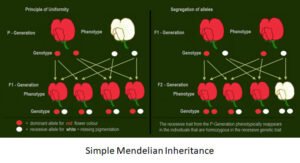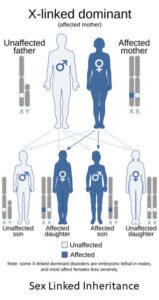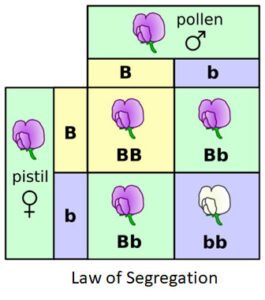When Gregor Mendel first experimented with pea plants, he discovered that traits are passed from parents to offspring in predictable ways. His work gave us the basic rules of dominant and recessive inheritance. But as scientists dug deeper, they found that inheritance is not always as simple as Mendel described. Let’s break down the different types of Mendelian inheritance patterns, using simple examples and analogies to make them easier to understand.
Genetics Quick Notes | Genetics PPTs | Genetics MCQs
(1). Simple Mendelian Inheritance – The “Masking Effect”
What it is: Traits are controlled by a pair of alleles (gene versions). If one allele is dominant, it will “mask” the effect of the recessive one.
👉 Example: In pea plants, purple flowers (P) are dominant over white flowers (p). So, both PP and Pp plants will have purple flowers, while only pp will be white.
Why it works: The recessive allele usually doesn’t make a working protein. Even half the amount (from one dominant allele) is enough to show the dominant trait—like having one strong light bulb in a room that’s still bright enough.

Sciencia58, CC0, via Wikimedia Commons
(2). X-Linked Inheritance – The “One Copy Problem”
What it is: Some traits are carried on the X chromosome. Since males have only one X (XY), they are more likely to show traits caused by recessive alleles, because they don’t have a backup copy.
👉 Example: Color blindness is more common in men because the gene is on the X chromosome. A woman would need two “bad” copies to be colorblind, but a man only needs one.
| You may also like NOTES in... | ||
|---|---|---|
| BOTANY | BIOCHEMISTRY | MOL. BIOLOGY |
| ZOOLOGY | MICROBIOLOGY | BIOSTATISTICS |
| ECOLOGY | IMMUNOLOGY | BIOTECHNOLOGY |
| GENETICS | EMBRYOLOGY | PHYSIOLOGY |
| EVOLUTION | BIOPHYSICS | BIOINFORMATICS |
Why it works: A female with one healthy allele can still make enough protein. A male with the recessive allele, however, has no second chance—so the trait is fully expressed.

File:Autosomal dominant – en.svg: Domaina, Angelito7 and SUM1Derivative work: SUM1, CC BY-SA 4.0, via Wikimedia Commons
(3). Incomplete Dominance – The “Blending Effect”
What it is: The heterozygote’s trait is somewhere in between the two parents. It looks like the traits are blending.
👉 Example: Crossing a red-flowered plant (RR) with a white-flowered plant (rr) gives pink flowers (Rr).
Why it works: One functional allele makes only half the protein, which isn’t enough to create the full red color—so the flowers appear pink instead. It’s like mixing red and white paint and getting pink.

Madprime, CC0, via Wikimedia Commons
(4). Codominance – The “Both at Once Effect”
What it is: Both alleles are expressed equally and visibly in the heterozygote. Nothing is hidden.
👉 Example: In human blood groups, the A allele and B allele are both expressed, giving AB blood type. Both A and B proteins show up on the red blood cells.
Why it works: Each allele makes a different protein, and both proteins appear together. Imagine wearing a striped shirt—both colors are visible at the same time, not blended.
(5). Sex-Influenced Inheritance – The “Hormone Twist”
What it is: Some alleles behave differently in males and females because hormones influence how the genes are expressed.
👉 Example: Pattern baldness in humans is dominant in men (more likely to cause baldness) but recessive in women. That’s why baldness is much more common in men.
Why it works: Hormones like testosterone and estrogen can “turn up” or “turn down” how a gene shows its effect. It’s like the same recipe tasting different depending on the cook’s choice of spice.
Wrapping It Up
Mendel’s original rules were the starting point, but inheritance is more versatile than just dominant and recessive.
- Simple inheritance is straightforward.
- X-linked inheritance explains why some conditions are more common in one sex.
- Incomplete dominance and codominance show us that traits can blend or appear side by side.
- Sex-influenced inheritance adds the twist of hormones to the story.
Genetics is like nature’s recipe book—sometimes traits blend like paint, sometimes they stripe like a shirt, and sometimes they’re influenced by whether the “cook” is male or female.
<<< Back to Genetics Quick Notes Page
| You may also like... | ||
|---|---|---|
| NOTES | QUESTION BANK | COMPETITIVE EXAMS. |
| PPTs | UNIVERSITY EXAMS | DIFFERENCE BETWEEN.. |
| MCQs | PLUS ONE BIOLOGY | NEWS & JOBS |
| MOCK TESTS | PLUS TWO BIOLOGY | PRACTICAL |
